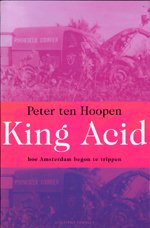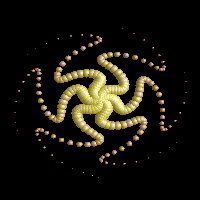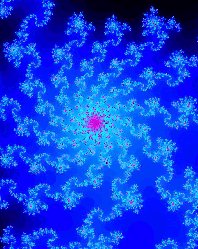|
KING ACID by Peter ten Hoopen Published in Dutch by Contact, 1998 
Complete English manuscript available for publishers and agents AMSTERDAM IN THE SIXTIES was a special kind of place. Along with San Francisco, London and Ibiza, it was one of the magic centres where 'it' was happening. People from all tribes flocked to Amsterdam for inspiration. To many it was, and still is, the Magic Centre - an old town where new ideas find fertile, albeit soggy ground. The city is hardly an isolated ghetto. The Netherlands as a whole serves as a pilot project for new approaches to the moral dilemmas facing mankind. Welfare, abortion, euthanasia and race relations are only some of the fields in which new limits of personal freedom are constantly being tested for side-effects on public well-being. Not surprisingly, no country in the world today allows its citizens more freedom for chemical exploration of the mind. Freedom is not a new notion in the Netherlands. For centuries the country has been governed by the classic liberal adage that people should be free to do what they like as long as they don't harm anyone else. This high-minded attitude, conducive to trade, science and the arts, has attracted men and women persecuted for their beliefs and practices elsewhere, and created a society that is surprisingly cosmopolitan for its size. Perhaps it was not just freedom per se, but rather this cosmopolitan character that attracted so many young people from all over the world to Amsterdam in the sixties. You could live in Amsterdam and feel at home right away. You could experiment with different life styles, new forms of expression, without fear of being ostracized. You could blast off into inner space, and upon return find yourself among a hospitable species that didn't make you feel like an alien.
Until the mid 1960's, LSD had been used by only a handful of people - almost exclusively within the framework of psychiatric research. Notwith-standing this depressing context, the majority of the chosen few delighted in their experiences and were eager to try again. Their vivid descriptions of hallucin-ations, visions, revived memories and personal transformations alerted writers, artists and philosophers to the possibilities of this amazing new substance. Alas, there was no way to gratify this desire for further exploration. It was next to impossible to obtain LSD, mescaline, or other powerful psyche-delics for use in private experiments. The key to the inner world was jealously held by the men in white coats who regarded themselves as the psyche's lawfully appointed guardians. Normal citizens who wanted to go out of their minds were allowed only booze. Nearly all painters had swollen livers. Growing demand, but no supply - the textbook recipe for a marketing breakthrough. When it came, early 1965, Amsterdam was suddenly treated to the methodical distribution of cheap, chemically pure LSD of constant dosage, presented in the form of sugar lumps. Only insiders could tell an acid soaked cube from an ordinary one. The lump was an instant hit, not least because, contrary to far less potent marihuana, it was legal. This situation was so hilarious that many trippers roamed the streets roaring with laughter. In the brief, idyllic period ending February 1966, when the old Opium Law was extended to include LSD, the city and its visitors absorbed a total of ten thousand of these pure white cubes.
The majority of those who experimented with LSD in this period of legality have done so using sugar cubes of my manufacture. This group of early psychonauts included people from all walks of life, but the most were artists or aspiring artists. (Few other people could have spared the time needed for voyages into inner space.) The monopoly was not complete. Fortunately not, says the voice of revolution; the more fuel the more fire. Occasionally someone would get some trips from the States, or a few Sandoz tablets that escaped from a psychiatric institution, but in that seminal year 1965 these cannot have amounted to more than a few score. A much more important alternative source was acid of local manufacture that was chemically impure, therefore unstable, and lost most of its potency in a matter of weeks. Trips from this source were readily identifiable by the brown spot that disfigured the sugar cube. How weak or how powerful they might be was found out by ingestion. Mine, I can state with unadulterated manufacturer's pride, were clean and pure, prepared with crystal LSD-tartrate, as stable as diamond. Should someone have any left today he'd find them every bit as powerful as thirty years ago. I speak of these events in the first person singular because to the outside world it seemed as if I was operating on my own. No one but a few intimate friends knew that I had a silent partner: Dr. Herman Cohen, who at the time taught social psychology at the University of Amsterdam. He actively collaborated in all areas but distribution; most significantly in the development of techniques to help people experience pleasant, enriching, illuminating or otherwise rewarding experiences. Later he would write his doctoral thesis on the theme of LSD use and sit on several government committees on drug use. In our joint endeavour we were inspired by the work of Timothy Leary, Richard Alpert and Ralph Metzner, all Harvard Ph.D.s, who were among the first to attempt to program psychedelic experiences, and deserve great credit for their courage to defy academic ridicule and leave behind the safe world of empirical knowledge. Dr. Cohen and I published articles and gave lectures on the subject, and I founded the 'Amsterdam Psychedelic Research Centre' with head offices in my apartment. A non-profit organization, it allowed a large number of tripping research subjects (friends and friends of friends) to profit from a reasonably competent attempt at guidance. Sometimes the guidance was quite structured, involving slide shows, pre-programmed audio tapes and planned brief outings, at other times it consisted of little more than something as basic as warmth and acceptance, and endless pots of tea.
This is not to suggest that we gave it to all and sundry. We seriously attempted to screen candidates. Alas, at times it was hard to establish wether someone had the inner stability to go through the ultimate test of ego-disintegration, formless existence and reintegration. Psychiatry, let it be entered into the record, has proved no better judge. To the contrary, the mass of published research reveals that the men in white coats produced a far higher percentage of bumtrips than the 'free sector'. If the same number of us had gotten the horrors, LSD would never have gotten as popular. Nearly all of the people we accompanied on their journeys gained a valuable experience of a world that they had never suspected to exist. It taught them more about themselves than they had ever expected could be known. In many cases it transformed their lives in a way that they still feel vociferously positive about. For this band of true psychedelians, George Harrison, the most spiritual Beatle, is a powerful and articulate spokesman. Even now, some thirty-five years after he was first turned on, he speaks of LSD glowingly (whenever an interviewer gives him half a chance), crediting acid with beneficial changes in his life, in particular his inner life. LSD may mean a weird flash, soon forgotten, a dramatic psychic change, or the start of an inner exploration for which no drugs are needed. The most prominent figures in this description of King Acid's court are not the sanest of the sample - which is not to be taken as a derogation of their souls. As I wandered back in time, I found myself staying longest with the least inhibited, and sometimes most disturbed of my friends. They were the most open, naked souls. As the kings of old knew, fools are more fun - and they have the wisdom. If this slant towards the weird leads the reader to think that we were all just a bunch of nutcases, I will do nothing to correct the impression. Mama, we're all crazy now! A few, sadly, would stay stuck in that mode. But leaving sanity behind has allowed many of us to becoming leading figures in our professions and an inspiration to many. Some of us are coming out now, some have always been out. In post-modern society, normalcy does not enjoy the same status as in the middle of the century, and it is revealed knowledge, certainly in the arts, that you can't be creative without opening yourself to forces that can turn themselves against you. As Goethe wrote in Der Zauberlehrling: "Herr, die Not ist gross! Die ich rief, die Geister, werd' ich nun nicht los." In my inspired translation (see A Real Bumtrip): "Oh Lord, mark my woe! Those I called up, those spirits, now I can't make go." We all face demons that entered our lives through the same door that allowed in the angels. Now we're with the angels, singing at heaven's door, now wrestling the demons. And oh, do we suffer! Even so, we seem to spend more time with our demons than with our angels. For the sake of social hygiene this had better remain unsaid, but the truth will out: angels get boring. The dark side that the demons lure us into, the realm where bloom the Flowers of Evil, is devilishly attractive. Unknown, mysterious, thrilling. And it yields better art. While writing Trance Caravan, the first of a trilogy of works documenting the changes of the sixties and the progress of my soul, I had to rely largely on memory, because my travel diaries were extremely succinct. For King Acid I could delve into my files of the period, all of which survived, thanks to moviemaker Johan van der Keuken, who let me store them on his attic during my years in the East: hundreds of clippings, articles and outlines for lectures, outgoing and incoming letters, bills for chemicals, resumes of books, ideas and thoughts, and whole cosmological theories. Jointly, they allowed me to reconstruct my then state of mind, which on essential points should be a fair representation of the period's collective state of mind. My mental landscape of those years looks like Vietnam did at the time: gorgeous scenery pocked with hundreds of craters. The majority represent the impact of standard 100 gamma doses, but many are 300 and 400 gamma hits and a few are simply huge. It is not that all memory of those bigger events has been wiped out, in fact some I remember with great clarity, it is rather as if the impressions have been amalgamated into a dense lump, as happens when a meteorite or a nuclear device strikes. Analyzing these lumps of mnemonic matter has taken Herculean effort of recall. Fortunately I was not the only one doing the recalling. Old friends have contributed their memory of events, often with great enthusiasm. This book could not have been written without them, and I wrote it in honour of them, those mad pioneers who explored new roads to sanity. This book is not partisan, it is not advocacy. I have no agenda, other than the promotion of freedom, notably the freedom of self-realisation. I just render a portrait of Amsterdam in a creatively rich period, a new golden age that imparted some powerful stimuli, the effect of which may have seemed to wane for a while, but today is felt ever more strongly. The perspective is that of one who could not but feel that many of those stimuli were given, or, in the spirit of the times, 'passed on' by him. The chosen technique is 'new journalism', a blend of journalistic and novelistic techniques based on personal participation and openness about emotional responses. This particular technique was chosen because it is ideally suited to describe historical events from the point of view of someone central to the action. In the words of Tom Wolfe, who baptised the phenomenon with his eponymous collection: "Any time a nonfiction writer uses an autobiographical approach, he is turning himself into a character in the story. This has a better chance of working if the writer was, in fact, a leading character in the events he is describing." The other leading characters are a group of young artists, largely Amsterdam citizens; largely long-haired, as those on Rembrandt's Nightwatch, and equally conscious of their role. King Acid, though, does not attempt a formal portrait; rather it presents a genre painting, detailing peoples' lives and circumstances, relating personal, intimate experiences. Many of these experiences could be described as travel: trips into inner space and journeys across the continent to spread the gospel and distribute the sacrament. In spiritual terms, this book describes a collective awakening and documents the exploits of the awakened during a crucial period, their first journeys into a world that is out of this world. All the above boils down to a sound-byte: "King Acid chronicles the serious attempt of a group of dare-devils to find out what it is that we all live for."
|


